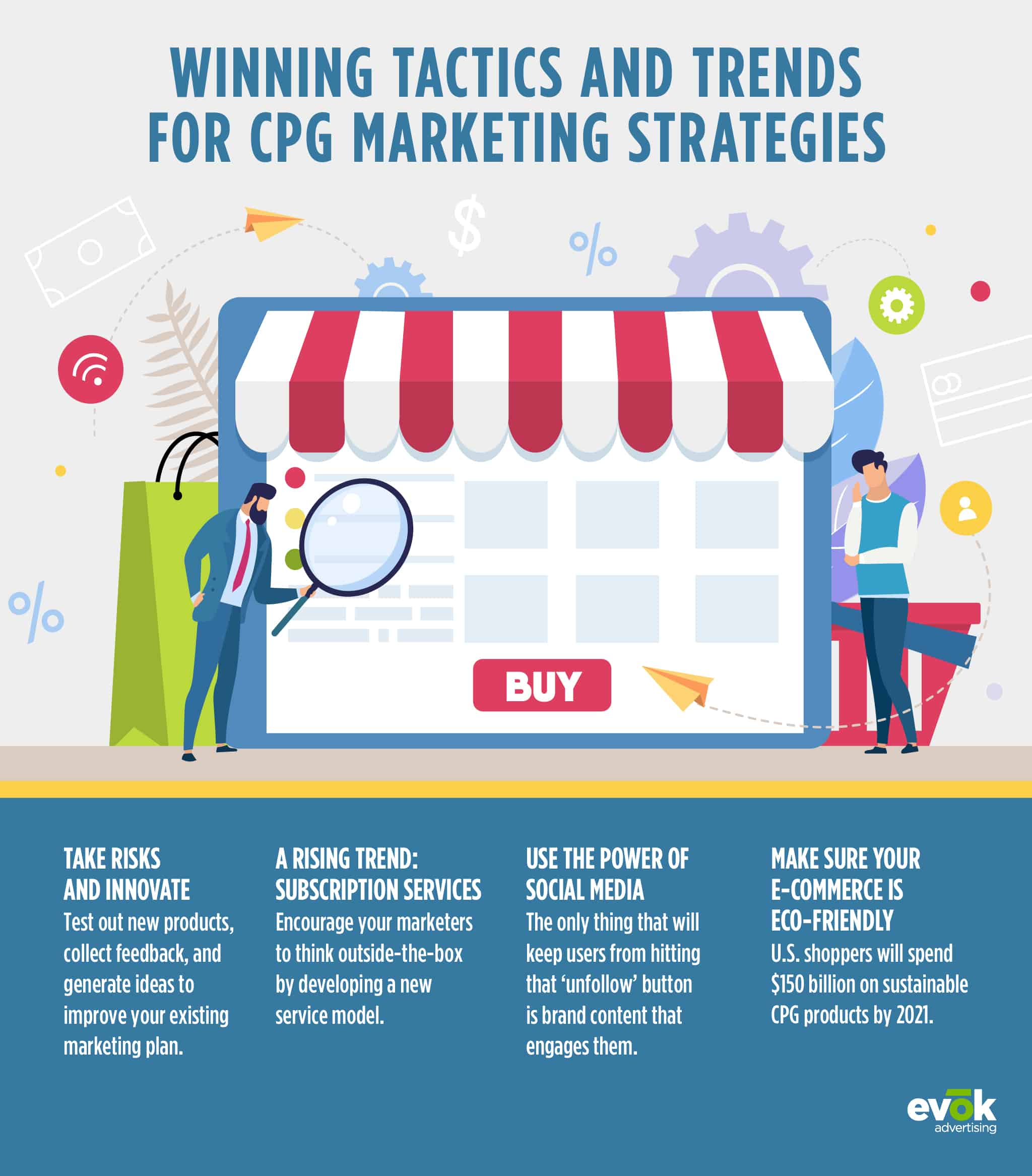
Updating & Balancing Your CPG Marketing Strategy: Winning Tactics & Trends

COVID-19 is by far one of the biggest challenges this generation has faced. CPG companies had to reinvent their marketing strategies, their messages, and how they reached their current and potential customers in order to survive during the pandemic.
CPG brands learned that resilience, innovation, agility, and empathy are marketing tools just as much as SEO, email newsletters, and data analytics. As society rises from the ashes of coronavirus, brands are having to update their CPG marketing strategies to keep up with consumer behavior shifts that occurred during the quarantine. We’ve collected the best advice, trends, and tactics to help you make these adjustments as smoothly as possible.
Take Risks & Innovate
Whether it’s your product, business model, or marketing strategy, you should always look for ways to innovate in the CPG market. If your business fails to keep up with the times or becomes complacent, you become irrelevant to consumers and will soon lose out to a competitor who is always looking for the next step forward.
“There comes a point, whether after achieving success or an unexpected crisis, such as COVID-19, where companies stick to what’s ‘safe’. Instead of looking at emerging trends and adapting, they focus on their strengths,” says Senior Account Manager, Heather Glenn, “Now is the time to move and adapt, otherwise you jeopardize growth. Don’t let fear keep you from taking risks. Being safe and doing what has proven successful in the past will not get you ahead now or in the future.”
CPG companies like Ben & Jerry’s, Arm & Hamer, and Tide are exemplary in their constant innovation to keep up with what their customers want. Ben & Jerry’s, for example, develops new flavors each year based on customer suggestions, including dairy-free options. They also collaborate with companies and celebrities outside their niche to create ice cream flavors that appeal to customer’s trends, like this year’s Netflix & Chilll’d ice cream flavor.
Utilize direct lines of communication you have with your customers, like on social media, to gather intel on consumer behavior trends and shifts to help take your product to the next level. Take a risk and test out new products, collect feedback, and generate ideas to improve your existing product line or marketing plan.
A Rising Consumer Trend: Subscription Services
Over the past few years, we have seen a rise in CPG brands offering subscription services. While many CPG companies still rely on retail partners for distribution, many are increasingly exploring how they can shift their business models to serve their customers personally and directly. Consider how certain dog toy manufacturers have created a subscription service for monthly toys and treats for their customer’s pups.
Many subscription services give consumers the option to personalize their boxes to meet their specific needs. Stitch Fix, a personal styling subscription service, surveys first-time customers to understand their sense of style so that the clothing delivered expresses the individual’s personality.
No matter what product or service your company offers, encourage your marketers to think outside-the-box to redefine your category by developing a new service model.
Be Present in the Digital World
Despite many states reopening to business as usual, many companies realized during quarantine that their employees are capable of working from home and that it has actually increased productivity and decreased costs. This means that people are still staying at home and are spending more time on their mobile devices and online platforms than they would at the office.
Although coronavirus disrupted marketing and advertising initiatives and CPG companies are slowly starting to return to their original digital marketing plans, we can expect marketers to keep their plans fluid and tweak their ad-spend to reach customers where they are. Here are a few platforms we think CPG brands should focus on updating and innovating:
Social Media
Social media is no longer an optional marketing effort in the CPG industry. A successful social media strategy is based on a strong content marketing plan. Content helps you build loyalty, and brand loyalty is foundational in the CPG industry. Once formed, the purchasing habits of consumers are nearly impossible to break.
Over 60% of consumers use social media to follow CPG brands that interest them, but the only thing that will keep users from hitting that ‘unfollow’ button is content that engages and attracts them. Instead of simply promoting your product, talk about how your product will solve a problem your consumers might have. Create content that shows off the personality of your brand. If your brand is full of young energy, make your posts humorous, witty, and sassy. If your brand is luxurious, make sure your images and videos exude that opulence.
Social media users are also the world’s largest, most honest, and open focus group. Leverage that. Tap into your social media audiences to sharpen your message and tweak your branding to better appeal to consumer behavior and increase return on investment (ROI).
E-Commerce

CPG brands were already making the switch to e-commerce platforms, but COVID-19 launched this sector of the industry to grow exponentially. With people being more aware of germs and social distancing regulations still being heavily enforced, potential customers are being drawn to online shopping more than ever in order to stay healthy and avoid inconveniences, like wearing a scratchy face mask. As CPG organizations look into expanding into the e-commerce realm, it’s important to keep in mind e-commerce marketing strategies and trends.
A major trend that affects both product packaging and marketing perspectives is sustainability. Eco-friendly products have been on the rise and have been proven to drive CPG sales with quality, focused marketing. 3 out of 4 consumers are willing to change their purchasing habits to improve the environment, and Nielson projects that U.S. shoppers will spend $150 billion on sustainable CPG products by 2021.
As more sales move online, CPG brands will have to think past sustainable product attributes and consider the larger environmental impacts of e-commerce shopping, such as packaging and shipping. Last year, Amazon began forcing brands to confront this issue by implementing the Frustration-Free Packaging a requirement. If a vendor wishes to sell items larger than 18” x 14” x 8” they must comply with the program’s rules on sustainable packaging and shipping or face potential repercussions.
Once you determine how you make your product sustainable from manufacturing to delivery, advertise that on social media and other marketing channels to get that news out to your customers.
Every industry is stumbling, trying to understand what their marketing efforts will look like as we step out of the quarantine daze and into the new normal. The CPG industry is no exception. Look a little deeper into your previously planned marketing strategy and find ways to take a risk and innovate your plans. Rise and blow your consumers away with a campaign that is revolutionary in creativity. Need a hand to help pick through the debris left behind by the pandemic and find a nugget that will launch your brand into the next level? As a Consumer Packaged Goods Marketing Agency, we’re in this together. Let us help you.